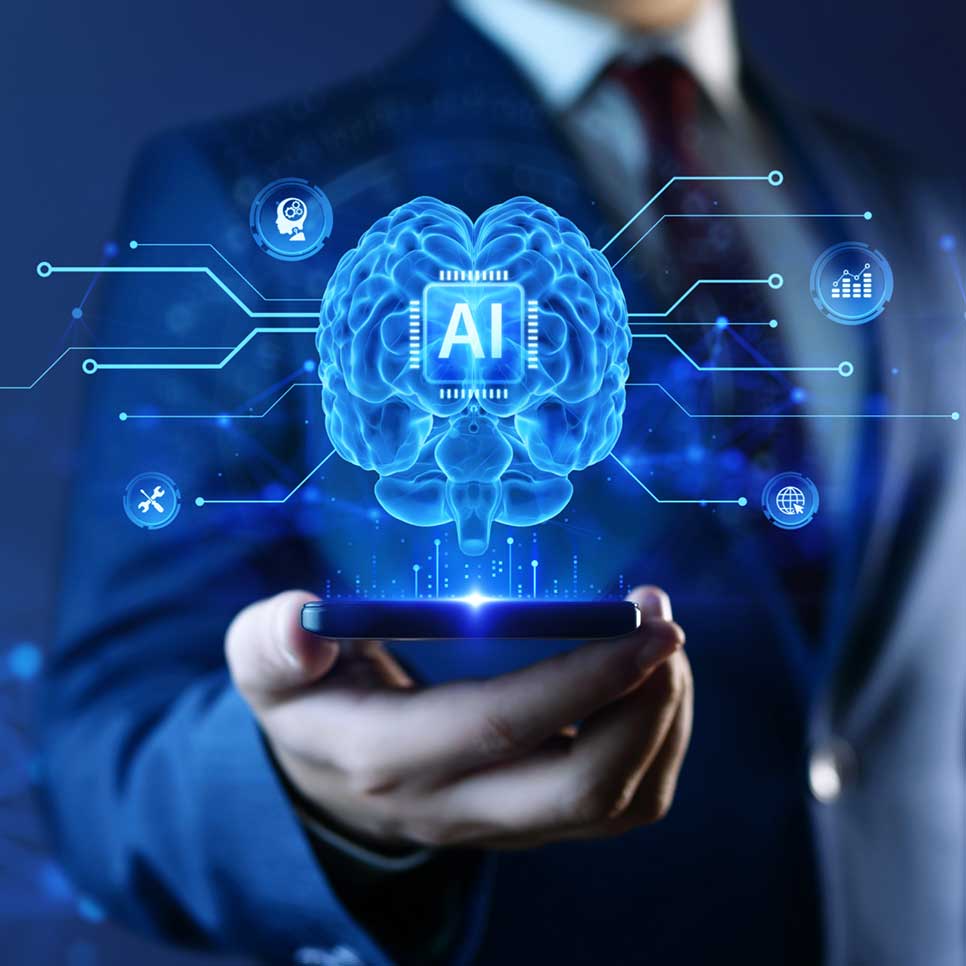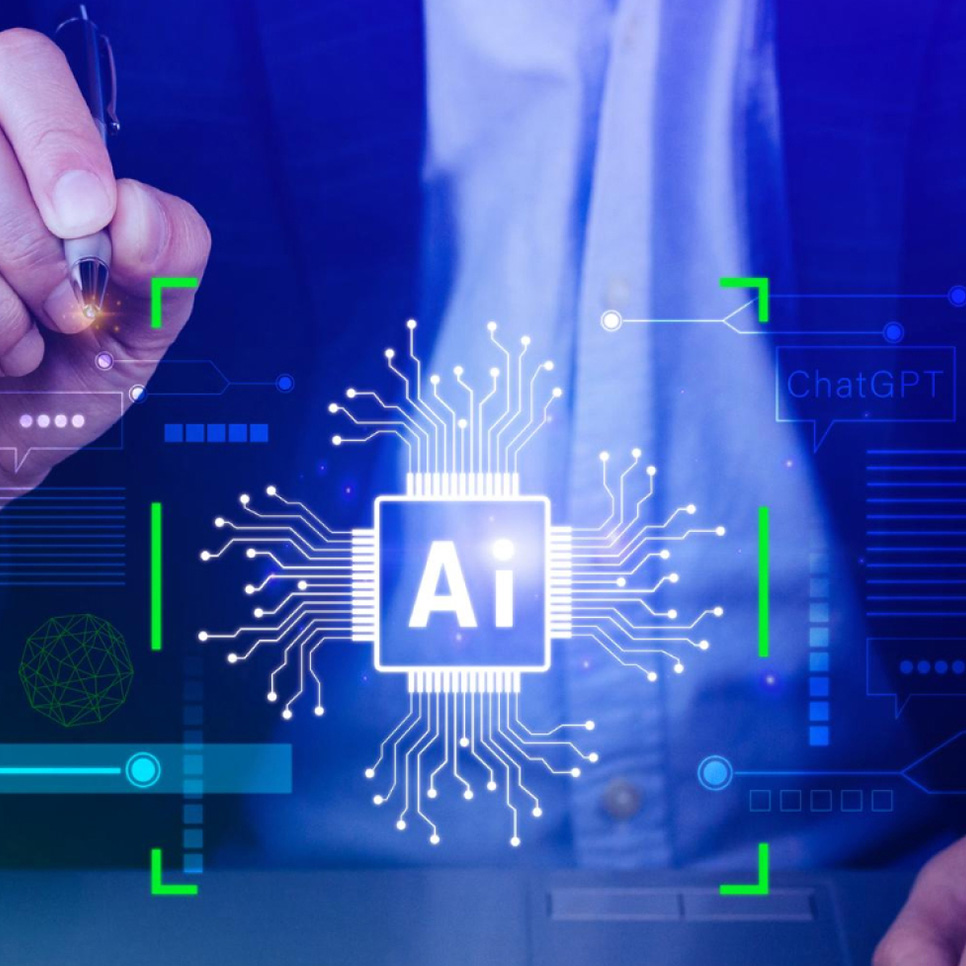Generative AI vs Predictive AI
BLOG
10 min read
Generative AI vs Predictive AI: Which Should You Choose for Your Business?
Recent advancements in artificial intelligence (AI) have prompted many businesses to explore AI to improve their operations. A McKinsey 2023 survey found that AI adoption did not reach 66 percent in any region; however, this year more than two-thirds of respondents in nearly every region say their organizations are using AI.
Generative AI and predictive AI remain at the helm of this transformation. Indeed, adopting Artificial Intelligence (AI) as a popular technology has brought about a revolution in the tech world. This transformation promises to transform how we live and work.
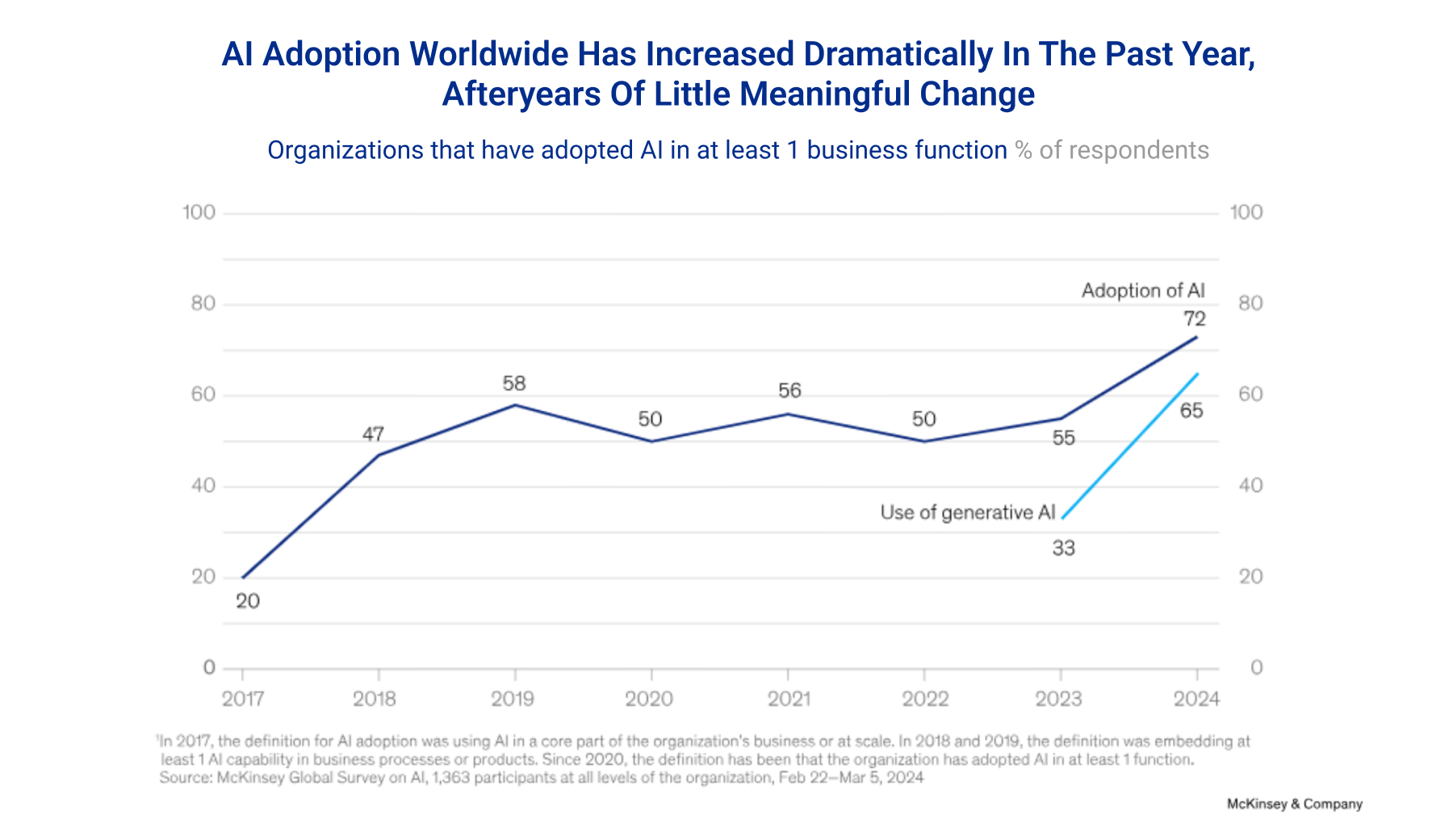
While many generative AI tools seem to possess predictive capabilities, it’s essential to note that generative AI is not predictive AI. While both are used for making predictions and decisions, they differ significantly in their approaches. Thus, both are distinct in their purposes and even in use cases. Generative AI, for instance, focuses on creating content – like images, text, and code based on specific user inputs. Generative AI adds a creative element to the output. Predictive AI, on the other hand, analyses large datasets to identify patterns, which are then used to forecast future outcomes.
Understanding these distinctions is extremely critical. In this blog, we will address the distinct characteristics of generative AI and predictive AI, highlighting their characteristics, roles in business, approaches, and so on.
Let’s explore these two technologies and compare them to understand how businesses can leverage these tools for optimal and sustainable growth and end the ever-growing debate of generative AI vs predictive AI.
What is Generative AI?
Generative AI is an algorithm that can create new content, including texts, images, music, code, and even complex simulations. It relies on deep learning models, which utilize the input from large datasets and generate unique outputs similar to the style and structure of the input data.
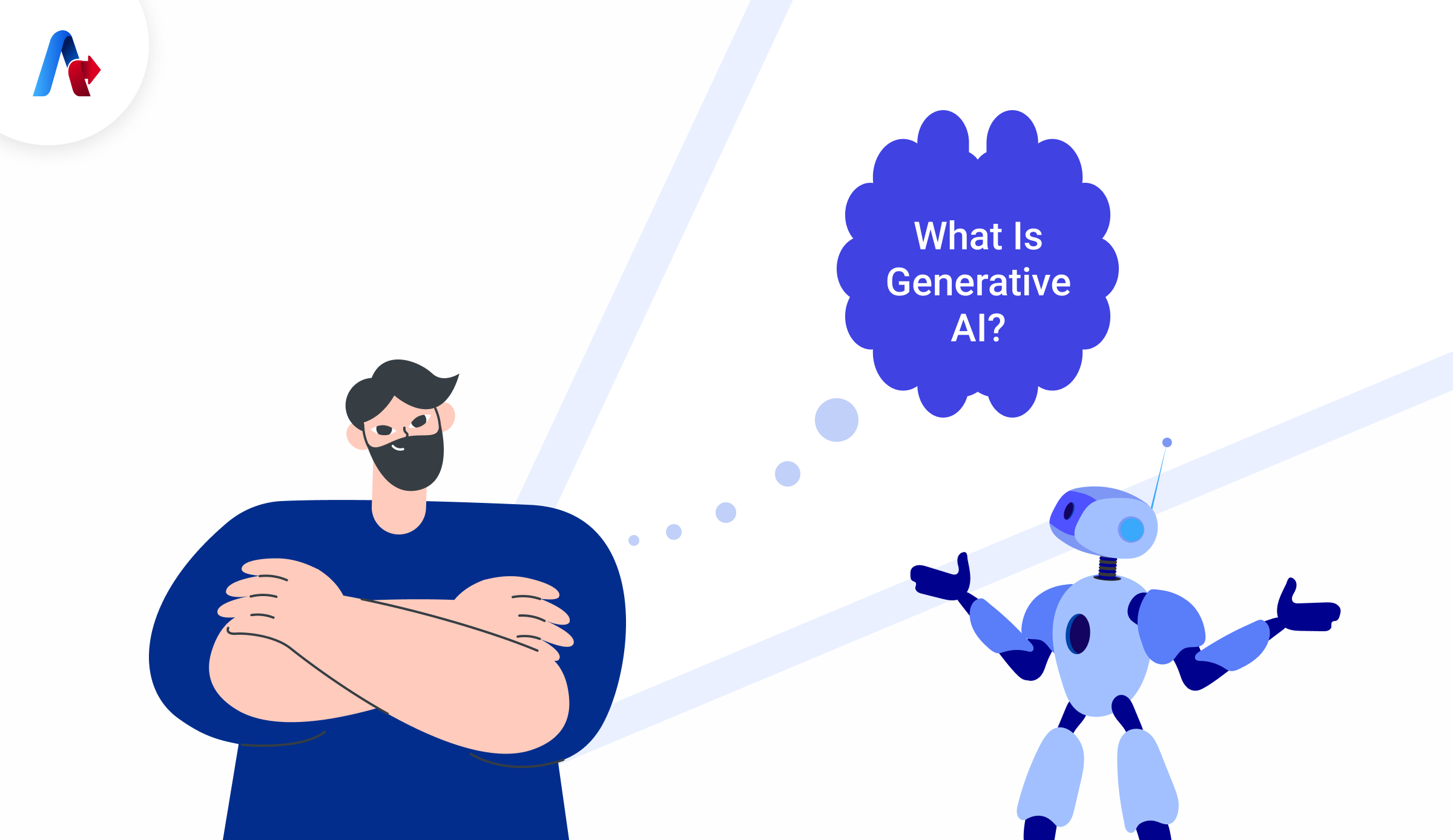
Generative AI for Business
Unlike predictive AI, generative AI is used more widely across businesses. For example, generative AI facilitates effective data augmentation practices, which helps in training other models despite scarce datasets. The most popular use of generative AI is probably content creation, which allows corporations to produce original content such as articles, blogs, music, logos, artwork, etc. Lately, businesses are increasingly using it to deliver tailored user experiences by personalizing recommendations across consumer interfaces.
The versatile capabilities of generative AI have enabled it to reach various applications across diverse industries, including healthcare, gaming, IT, and, most importantly, creative.
In the latest McKinsey Global Survey on AI, 65 percent of respondents report that their organizations are regularly using gen AI, nearly double the percentage from our previous survey just ten months ago.
What is Predictive AI?
Predictive AI, unlike generative AI, analyses existing data to make forecasts – or predictions – about future outcomes. It utilizes historical data and statistical techniques, which, coupled with machine learning algorithms, uncover patterns and trends. These forecasts can become instrumental in helping businesses make informed decisions, optimize operations, and proactively identify potential risks.
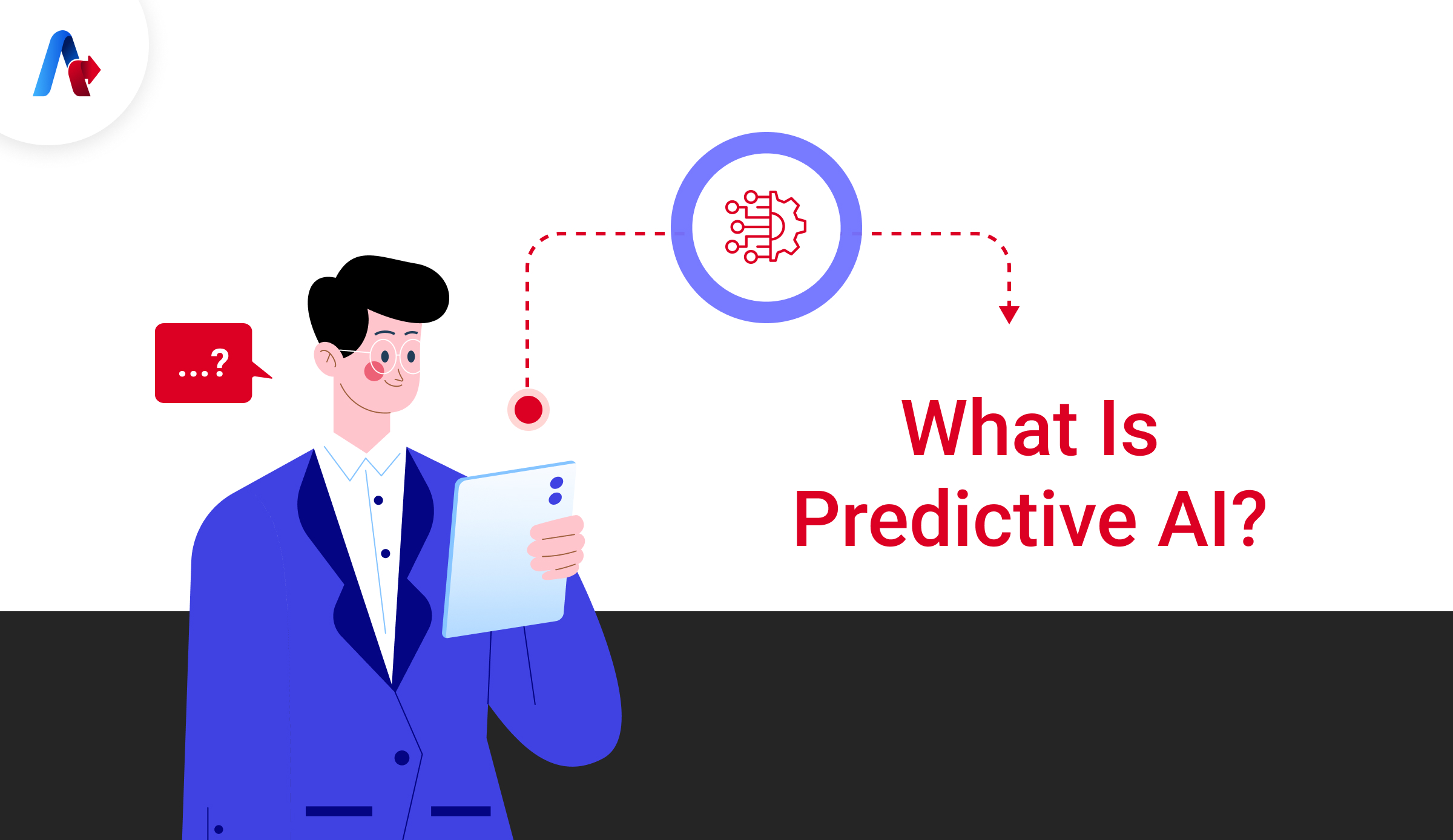
Predictive AI for Businesses
Predictive AI is becoming more well-known in the world of AI technologies. Businesses can be more proactive instead of reactive by employing predictive AI. Most importantly, it offers insights that are essential for effective planning and decision-making and allows for more active risk assessment portfolios, thus helping businesses mitigate potential issues even before they arise.
The decision-making and risk-assessment capabilities of predictive AI makes it a favourite of sectors that rely heavily on both. Thus, wide-scale application of predictive AI is prevalent in supply chain, manufacturing, ecommerce, finance, and marketing verticals.
What else can Predictive AI do for your business?
Let’s discuss!Generative AI vs Predictive AI – Key Differences
Generative AI and predictive AI are essentially different in the way they work and function, but both have almost equal significance in the world of business. An in-depth knowledge about the differences of these two technologies can not only help businesses make better decisions but can also enable them to harness the power of both effectively. The key difference between generative AI and predictive AI can be categorized as the following:
| Aspect | Generative AI | Predictive AI |
|---|---|---|
| Goals | Create new content | Predict outcomes based on existing data |
| Input | Large, diverse datasets | Smaller, focused datasets |
| Output | Original data (text, images, etc.) | Predictions and probabilities |
| Methodology | Uses algorithms like GANs and VAEs | Utilizes statistical methods and machine learning |
| Applications | Content creation, design, drug discovery | Market forecasting, customer behavior analysis |
1. Goals – Generative AI vs Predictive AI
The primary goal of using generative AI is to create completely new content. Thus, its chief purpose is to help businesses as well as individuals be more innovative and creative.
Predictive AI as a tool focuses on detecting patterns from existing data. As such, its primary objective is to predict possible outcomes across specific functions, such as market trends, customer behaviour, machine failures, etc.
2. Input – Generative AI vs Predictive AI
Generative AI works by learning from thousands of datasets, which characteristically include heterogeneous data of all kinds, including images, audio, texts, source codes, and so on.
The input used by predictive AI is usually smaller and more focused datasets specific to the task. Thus, the input is more streamlined and particular, unlike generative AI.
3. Output – Generative AI vs Predictive AI
Generative AI generates completely new data or information. As such, the output remains original in the sense that it did not exist prior to the use of generative AI.
Predictive AI delivers outputs that are not facts. Since the technology uses historical data and patterns to predict possible outcomes, the output involves expected scenarios and nothing definite.
4. Methodology – Generative AI vs Predictive AI
Generative AI utilizes complex iterative algorithms such as generative adversarial networks (GANS) and variational autoencoders (VAEs).
Predictive AI leverages different forms of statistical and machine learning techniques to estimate the most plausible outcome in the future.
5. Application – Generative AI vs Predictive AI
Generative AI is used in multiple domains, including but not limited to content creation, designing, game developing, drug discovery, and so on.
Predictive AI is used in industries such as finance, healthcare, digital marketing, stock market, etc.
What’s your strategy for adopting AI?
Tell Us Today!Generative AI vs Predictive AI – A Comparative Analysis
| Aspect | Generative AI | Predictive AI |
|---|---|---|
| Purpose | Creates new content (text, images, music, etc.) | Analyzes data to forecast future outcomes |
| Data Requirements | Requires large, diverse datasets | Works efficiently with smaller, focused datasets |
| Use Cases | Content creation, data augmentation, design | Market forecasting, healthcare predictions |
| Functionality | Generates unique outputs based on learned patterns | Identifies patterns in historical data to inform decisions |
| Applications | Content creation, design, drug discovery | Market forecasting, customer behavior analysis |
Purpose and Functionality
- Generative AI is primarily focused on creation and production of new content in a multitude of formats, including texts, images, music, code, etc. It learns from existing data and uses that data to generate unique outputs that mimic or resemble the original data to some extent. Thus, generative AI has the capability to brainstorm ideas, generate authentic ideas, create personalized content, and deliver artistic renditions.
- Predictive AI, in contrast to generative AI, focuses solely on analysis, and leverages historical as well as current data to derive plausible conclusions that forecast future outcomes. To put it simply, predictive AI identifies patterns in the data and informs the decision-making process by pinpointing potential risks and anticipated changes. Thus, while generative AI generates new content based on accumulated data, predictive AI forecast plausible future outcomes by analyzing historical and current data.
Data Requirements
- Generative AI typically requires large datasets to train models effectively. The quality and diversity of training data directly impacts the creativity of the generated data. Thus, the greater and more diverse the amount of data a generative AI model trains on, the better and more unique will be its outputs.
- Predictive AI, on the other hand, can work efficiently even with a smaller dataset, and the amount of data it needs to analyze depends immensely on the type and extent of the outcome it attempts to predict.
Use Cases
- Generative AI is used widely in tasks that are directly related to creative outputs and similar scenarios that necessitate innovation and authenticity. It is also being increasingly used for data augmentation, which requires the creation of synthetic data to facilitate model training.
- Predictive AI excels in use cases where understanding past trends is critical to inform future actions. For instance, healthcare providers can seamlessly predict patient outcomes based on the past medical records and accelerate the process of healthcare delivery.
Generative AI vs Predictive AI – Which to Choose
As is evident from the comparison between generative AI and predictive AI, it is clear how different yet equally crucial both these technologies are. As for businesses, choosing between the two is the real task. Walking through the following factors can help businesses make a sound decision.
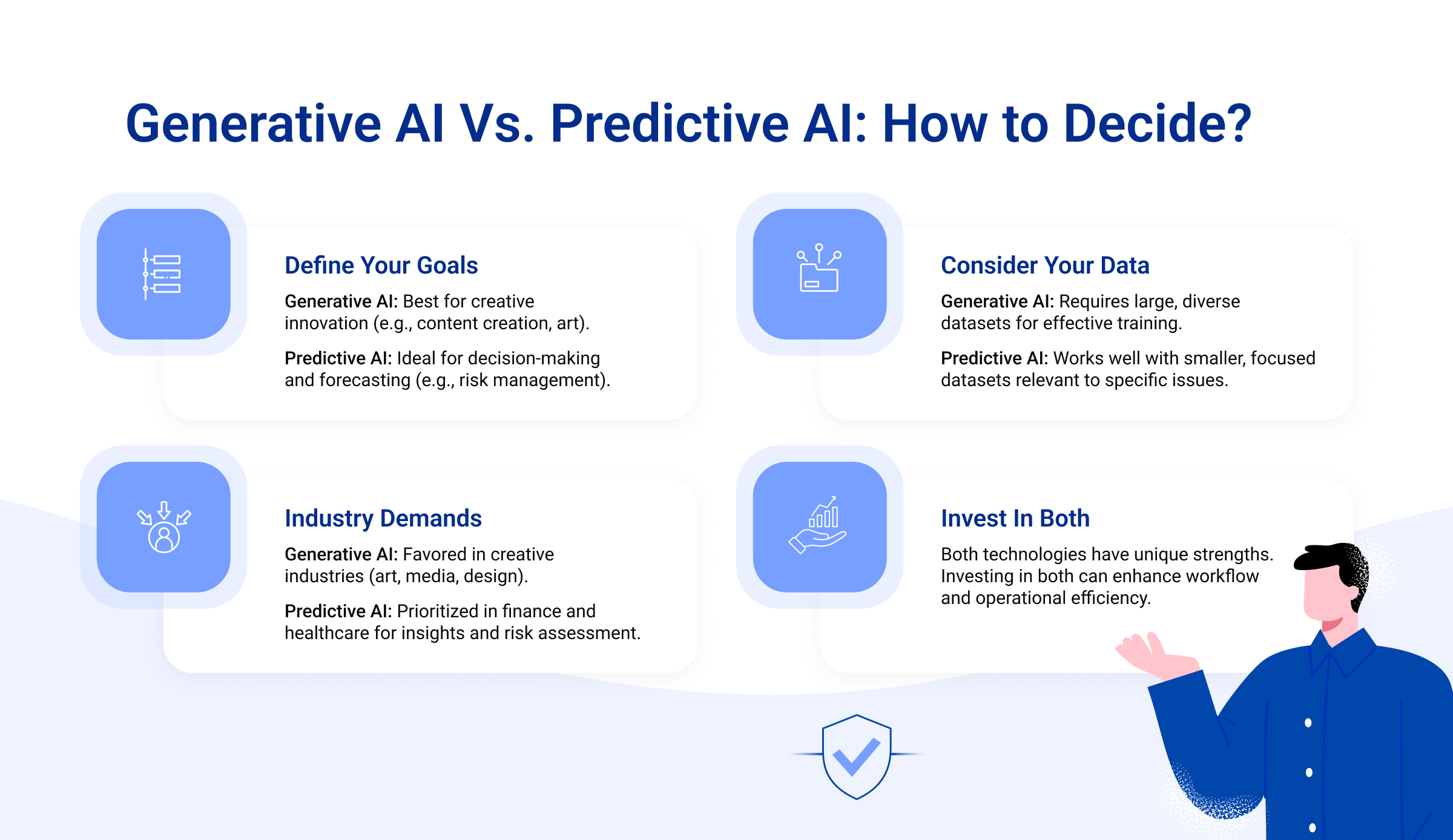
1. Define Your Goals
First and foremost, consider the goals. Businesses should have specific goals and a well-planned plan to follow through. Identifying this goal will do half of the work. For instance, if the goal is creative innovation, then generative AI has to be used. On the other hand, predictive AI will be more appropriate if decision-making and forecasting are required.
2. Consider Your Data
Consider the type of data that needs to be tackled. Not all types of data are the same and neither can they be used to derive similar results. Every bit of data has its purpose. If the available data is huge, adequate for training models, generative AI can be leveraged effectively. In contrast, if available data is limited but relevant to specific issues, predictive AI may yield better insights.
3. Industry Demands
Identify demands within the industry and scope. Different industries have varying demands. While creative sectors might favor generative AI, finance and healthcare may prioritize predictive AI for risk management and forecasting.
While the above points are intended to help businesses make an informed decision about predictive AI vs generative AI, it is essential to note that both these technologies have distinct uses. As such, businesses will do well if they invest in both. Each of these technologies can address their respective areas of expertise and offer businesses the benefit of a cohesive workflow.
Generative AI vs Predictive AI - Beyond the Debate
The choice between generative AI solutions and predictive AI ultimately hinges on your specific objectives and the context in which you operate. Both these forms of AI hold immense potential for businesses and hence, it is foremost essential to understand their strengths, capabilities, as well as limitations. A sound knowledge can help businesses align their investments with strategic goals and get better outcomes.

